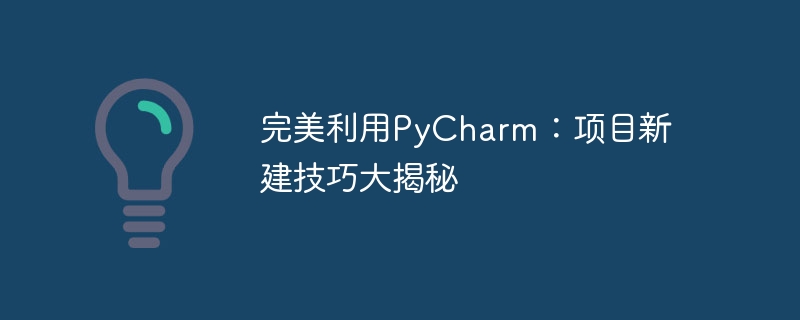

Perfect use of PyCharm: Revealed project creation skills, specific code examples are required
Foreword:
In the Python development process, choose a suitable integrated development environment (IDE) is very important to improve development efficiency. As one of the preferred IDEs for Python development, PyCharm has rich functions and powerful plug-ins, which can greatly improve development efficiency. This article will introduce the techniques for creating new projects in PyCharm, including project type selection, project structure planning, and project configuration. It will also be explained with specific code examples to help readers better use PyCharm for project development.
1. Project type selection
When creating a new project in PyCharm, you first need to select a suitable project type. PyCharm supports a variety of different types of projects, including pure Python projects, Django projects, Flask projects, etc. According to different needs, selecting the corresponding project type can allow PyCharm to provide more convenience for the project.
def hello_world():
print("Hello, World!")
hello_world()from django.http import HttpResponse
def index(request):
return HttpResponse("Hello, Django World!")
from flask import Flask
app = Flask(__name__)
@app.route('/')
def hello_world():
return 'Hello, Flask World!'
if __name__ == '__main__':
app.run()2. Project structure planning
After the project is created, reasonable project structure planning can effectively improve the maintainability and readability of the code. PyCharm provides some shortcut operations to easily manage the project structure.
# 项目结构
|- myproject
|- __init__.py
|- package
|- __init__.py
|- module1.py
|- module2.py
|- main.py# module1.py
def add(x, y):
return x + y
# module2.py
def subtract(x, y):
return x - y3. Project configuration
During the project development process, PyCharm provides a wealth of project configuration options, which can help us better carry out development work.
Summary:
This article introduces the techniques for creating new projects in PyCharm, including project type selection, project structure planning, and project configuration. By rationally utilizing the functions and quick operations provided by PyCharm, the development efficiency of the project and the maintainability of the code can be greatly improved. I hope readers can use this article to better utilize PyCharm for project development and improve their programming abilities.
The above is the detailed content of New PyCharm Project: Best Tips Revealed. For more information, please follow other related articles on the PHP Chinese website!
 How to change pycharm to Chinese
How to change pycharm to Chinese
 pycharm installation tutorial
pycharm installation tutorial
 How to solve the problem that pycharm cannot find the module
How to solve the problem that pycharm cannot find the module
 How to install pycharm
How to install pycharm
 The difference between python and pycharm
The difference between python and pycharm
 How to configure the pycharm environment
How to configure the pycharm environment
 How to install the pycharm interpreter
How to install the pycharm interpreter
 What does pycharm mean when running in parallel?
What does pycharm mean when running in parallel?




